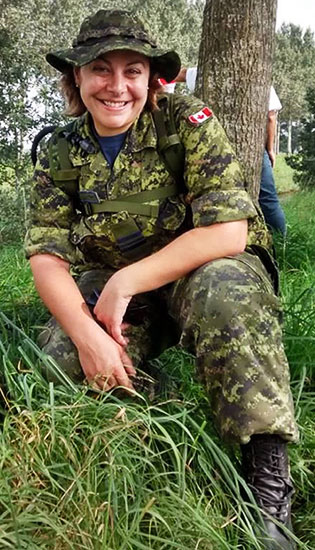Fighting the Good Fight
March 25, 2021 - Defence Stories
By: LCol Laura Laycock

Caption
LCol Laycock in 2014.
It was October 7, 2019 and not only was life good, it was amazing! My career in the Royal Canadian Air Force was going great. I loved my job and was getting promoted. Throughout my Canadian Armed Forces career of over 20 years, I had represented Canada around the world: with NORAD, NATO and the UN. I had married the most incredible man. We relocated to Ottawa, started to travel the world together, and were ready to start a family. Then, on October 8, 2019, everything changed.
I was diagnosed with Chronic Myeloid Leukemia (CML) after blood work for vertigo showed extremely elevated white blood cell counts. CML is a blood cancer where the bone marrow overproduces white blood cells, which eventually impairs completely the development of white and red blood cells and platelets. It’s usually caused by a spontaneous mutation in DNA, which contains our genetic code.
Twenty years ago, researchers developed a new line of drugs that combat this overproduction of white blood cells. These targeted oral chemotherapy pills have been revolutionary in the fight against CML. Most people who take them do so for the rest of their lives and have good survival rates. A stem cell transplant remains the only actual cure, but it’s risky and is not needed for most people.
It’s now been about 17 months since my diagnosis and my body has not tolerated this targeted chemotherapy. I fall into that small fraction of people who get debilitating or life-threatening side effects from this medication. My doctors are discussing other treatment options, one of which is a stem cell transplant, but my mixed ethnicity (European/Middle Eastern) has made it difficult to find a donor match.
My journey since my diagnosis has been to slow down and educate myself so that I can heal and advocate for my care; to appreciate every little moment of joy; and to do my best to overcome each challenge that arises. I have found strength in the extraordinary support I’ve received from my family, my friends and my community, both old and new.
With the help of family and friends, I recently began a social media campaign to increase stem cell donor education and registration in Canada and around the world. Many people are unaware of the potentially lifesaving role they can play by registering to become stem cell donors. Stem cell transplants are vital treatment options for people with a range of medical conditions including spinal cord injuries, heart disease, diabetes and some cancers.
Many people are unaware of the lifesaving role they can play by becoming stem cell donors.
The process to donate is simple. First, you register online with Canadian Blood Services or Héma-Québec and do a mail-in cheek swab. Then you wait. It could be months or years before you are identified as a match. During this waiting period, you should update your contact information with the registry if it changes. When you are matched, you will be contacted to continue with the donation process. This process is similar to giving blood, but it has its differences. The cells are usually collected intravenously from peripheral blood in a non-surgical procedure but, in rare cases, they are collected directly from the bone marrow in a surgical procedure. In either case, the risks associated with donating are minor.
In Canada, individuals aged 17-35 can register to become stem cell donors (ages 18-35 in Quebec). Both CBS and Héma-Québec are part of an international network of donor registries from over 50 countries. This network has a pool of over 38 million donors but, unfortunately, matches are rare. So your stem cells could potentially help others around the world! And throughout this process, donor privacy is assured at all times.
Stem cell matching relies on Human Leukocyte Antigen typing, which is highly influenced by ethnicity. This means that a patient’s best chance of finding a matching donor is from those who share similar ethnic backgrounds. Research conducted by Gragert et al. (2014) has shown that the likelihood of finding a match for certain ethnic groups can be as low as 16% and as high as 75% for others. This disparity highlights the need for more ethnically diverse stem cell donors in our registries.
Today, I am calling on my DND and CAF families to register as stem cell donors to help people, like me, who are fighting for our lives. If you aren’t able to register, please share this call with those who can. You, or someone you know, could be the match that saves a life -- a simple swab is all it takes to be a hero!
Links to register as a stem cell donor
- Canadian Blood Services (You are now leaving the Government of Canada website)
- Héma-Québec (You are now leaving the Government of Canada website)
- Swab the World (You are now leaving the Government of Canada website)
You can follow Laura’s campaign on
- Facebook: @MyBattleWithLeukemia
- Twitter: @MBWLeukemia
- Instagram: @MyBattleWithLeukemia